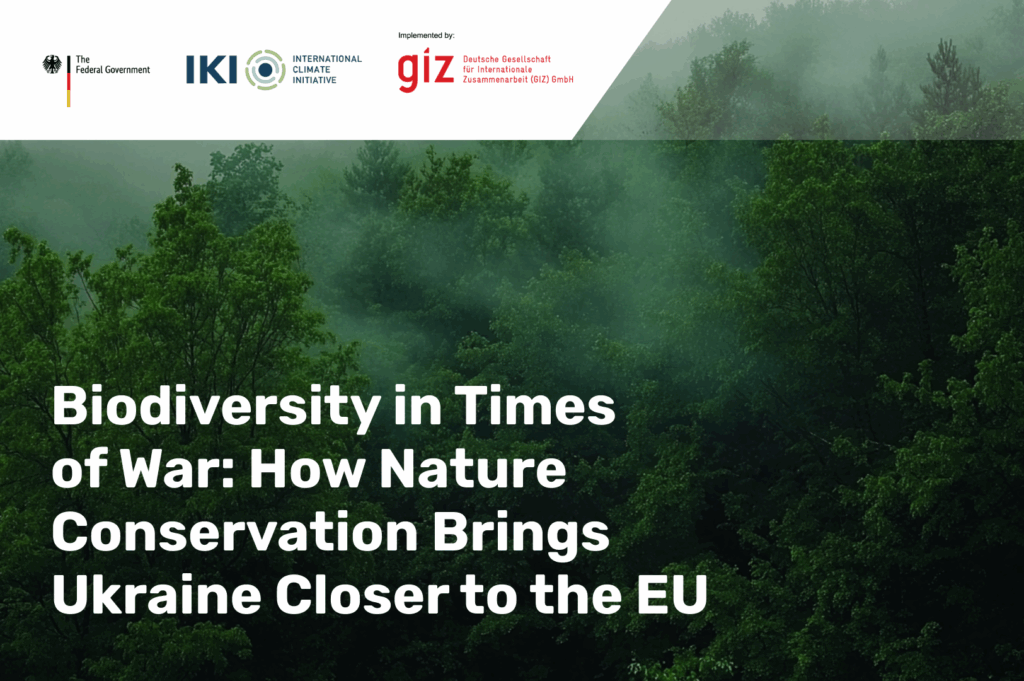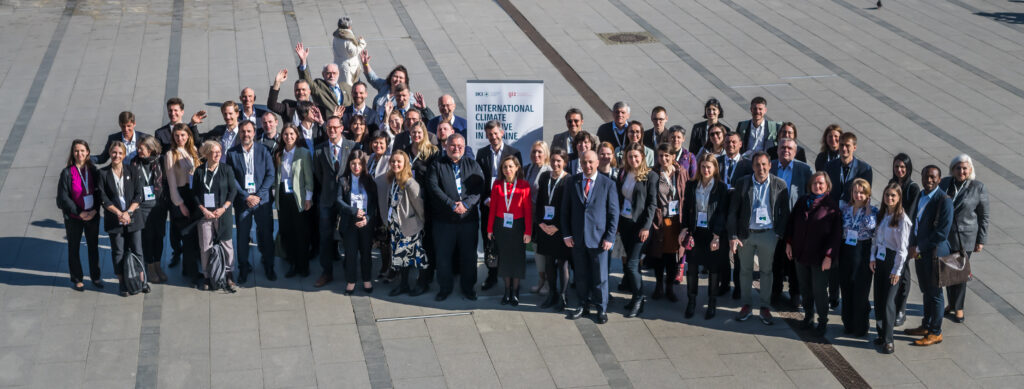Author: Volodymyr Domashlinets, Forestry and Biodiversity Expert, IKI Interface Project (GIZ)
While Ukraine is fighting for its freedom, the issue of environmental protection often seems secondary. Yet the destruction of nature directly affects people’s lives: the war is destroying forests, steppes, and wetlands, poisoning soils and water bodies. This is not only an environmental issue but also a food, economic, and security problem. If the country aims not only to recover but also to build its future as a full member of the European Union, biodiversity conservation must become a priority now — since public health, food quality, clean water, and economic resilience depend on it.
Today, as the war continues, we must talk not only about the losses of nature but also about how to preserve ecosystems under constant attack, which is also critical for Ukraine’s commitments to the European Union. Biodiversity is not an abstraction but a resource that determines whether we will be able to produce safe food, provide people with drinking water, and reduce health risks.
In this column, we will delve into why biodiversity is the foundation of Ukraine’s European future, how the war affects it, and what we can do to preserve it. We will also explain why Ukraine’s recovery must concern not only cities and roads but also the comprehensive restoration of ecosystems — since this is the foundation of our life.
The Cost of Destruction and Its Impact on People
Russia’s full-scale invasion has become a catastrophe not only for cities and people but also for Ukraine’s nature. Ecosystems formed over thousands of years are being destroyed in days due to shelling, heavy machinery, fires, explosions, mining, and the construction of fortifications. Forests, steppes, and wetlands are turning into dead zones, while habitats for plants and animals are being lost. These losses have direct consequences for people: contaminated soils reduce natural fertility, and some agricultural lands become unsuitable for farming, which directly affects harvests and people’s well-being.
Water pollution also directly affects human life: chemicals from munitions, fuel, and destroyed industrial facilities poison rivers, lakes, and groundwater. These ecosystem changes will remain for decades and impact food security, public health, and the economy. Already, around 10 million Ukrainians have no access to safe and reliable water supply, and 20 million lack access to centralized wastewater collection and treatment.
The catastrophe caused by Russia’s destruction of the Kakhovka Hydroelectric Power Plant in June 2023 wiped out complex aquatic ecosystems: countless fish and other aquatic organisms, birds, amphibians, and reptiles died; habitats of rare and endemic species disappeared. According to some estimates, the losses to the fishing industry due to the dam’s destruction exceeded 11,000 tons of fish worth 10 billion UAH, significantly reducing access to an important food source for the population and depriving thousands of fishers and related businesses of income. According to the Ministry of Environmental Protection and Natural Resources of Ukraine (now integrated into the Ministry of Economy, Environment, and Agriculture), the environmental damage from this act of terrorism is estimated in the tens of billions of hryvnias.
These examples demonstrate: nature restoration is not a distant prospect but a critical condition for survival and development now. While Ukraine is fighting for its right to freedom, it also has the chance to lay the foundation for a new model of recovery — sustainable, safe, human- and environment-oriented. For this, it is important not only to react to the consequences of war but also to act proactively — building a system that protects natural resources from further loss. Here, international environmental obligations, particularly those linked to European integration, play a significant role.
Why Biodiversity Is Not Just an EU Requirement but a Matter of Survival
Ukraine’s accession to the European Union requires fulfilling a number of environmental commitments aimed at improving quality of life and ensuring the long-term well-being of the population. For example, the Association Agreement (Chapter 27) contains a separate section devoted specifically to nature protection. It stipulates that the country must harmonize its legislation with European law by implementing the EU Habitats and Birds Directives. Their goal is to preserve natural habitats and populations of plants and animals, preventing their degradation and loss. These directives formed the basis for the creation of Europe’s largest ecological network, Natura 2000. Ukraine has committed to developing its analogue — the Emerald Network, which already covers 377 sites.
However, the essence of these documents is not limited to legal formalities. They are intended to safeguard the fundamental resources on which human life depends: soils, water, air, and the food base. During the war, these natural resources have come under threat. According to the Ministry of Environmental Protection and Natural Resources of Ukraine (now the Ministry of Economy, Environment, and Agriculture of Ukraine), about 20% of protected areas have already been damaged or are at risk of destruction. This means the loss not only of rare species but also of fertile lands and associated natural complexes capable of providing essential ecosystem services.
The problem becomes even more acute in light of the global “30 by 30” goal, supported by Ukraine: by 2030, 30% of land and marine areas must be conserved. This task seems harder today than ever before, but its importance only grows. The more territories are destroyed or polluted, the fewer areas remain where safe crops can be grown, drinking water obtained, and ecological resilience maintained.
Thus, biodiversity is not merely an abstract EU requirement or a condition for access to European markets. It is a matter of the country’s survival: our food, health, economic stability, and ability to rebuild after the war at a qualitatively new level.
Ukraine’s Next Steps: The Path to Recovery and a European Future
Despite enormous challenges, Ukraine has a unique chance to rethink its development model and integrate respect for nature as a cornerstone of future recovery. This is not only about environmental protection but about security, resilience, European integration, and long-term reconstruction. In this context, several interrelated directions must form the ecological architecture of Ukraine’s future:
- Development of a National Biodiversity Strategy and Action Plan. A working group is already drafting a strategic document that takes into account post-war challenges, aligns with the decisions of the Conference of the Parties to the Convention on Biological Diversity, meets European requirements, and will become the foundation for long-term conservation policy.
- Integral environmental monitoring, including biodiversity. Effective management of natural resources is impossible without accurate, up-to-date information about their condition. Therefore, establishing a modern monitoring system becomes a top priority. The project “IKI Interface: Supporting Ukraine on the Path to an Ambitious and Integrated Climate Policy (GreenUkraine),” implemented by Deutsche Gesellschaft für Internationale Zusammenarbeit (GIZ) GmbH, is working in this direction. Within the project, technical support is planned for the development of biodiversity monitoring in Ukraine and the implementation of other wildlife protection measures, enabling informed decision-making, timely responses to threats, and effective natural resource management.
- Ecosystem restoration. Priority actions include demining territories, land reclamation, and the restoration of water bodies, steppes, and forests. Such measures not only return natural wealth but also strengthen community resilience and contribute to their economic recovery.
- Harmonization of legislation with EU standards. Implementing the Habitats and Birds Directives and other EU nature protection legislation is a necessary condition for integrating into the European ecological space and gaining access to financial support instruments.
- Expansion of international partnerships. The implementation of large-scale conservation programs requires the involvement of experts, donors, investors, and coordination between state and non-state actors.
The future of Ukraine depends on which path we choose — a fragmented one focused only on infrastructure, or a holistic one that includes nature. Efforts to preserve and restore biodiversity are not a technical task but a defining choice: whether to remain a state vulnerable to ecological crises or to become resilient, responsible, and truly European. If these actions are consistent and coordinated, Ukraine will be able not only to restore what has been destroyed but also to create a new model of harmonious coexistence with nature.
This material was prepared by the project “IKI Interface: Supporting Ukraine towards Ambitious and Integrated Climate Policy (Green Ukraine)”, implemented by Deutsche Gesellschaft für Internationale Zusammenarbeit (GIZ) GmbH on behalf of the Federal Ministry for Economic Affairs and Energy (BMWE), within the framework of the International Climate Initiative (IKI).

